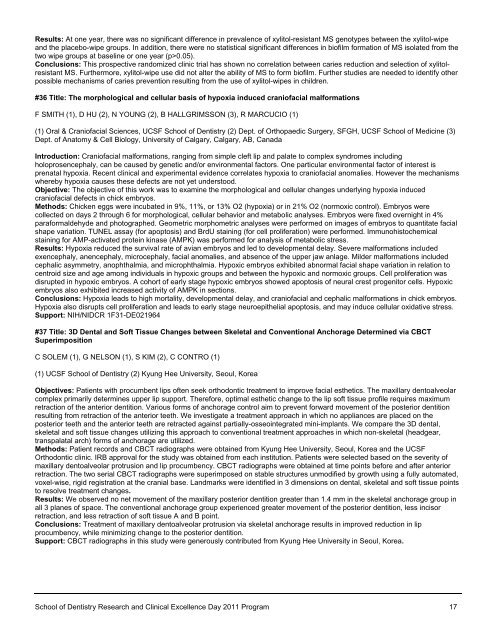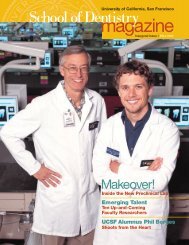Acknowledgements - UCSF School of Dentistry - University of ...
Acknowledgements - UCSF School of Dentistry - University of ...
Acknowledgements - UCSF School of Dentistry - University of ...
Create successful ePaper yourself
Turn your PDF publications into a flip-book with our unique Google optimized e-Paper software.
Results: At one year, there was no significant difference in prevalence <strong>of</strong> xylitol-resistant MS genotypes between the xylitol-wipe<br />
and the placebo-wipe groups. In addition, there were no statistical significant differences in bi<strong>of</strong>ilm formation <strong>of</strong> MS isolated from the<br />
two wipe groups at baseline or one year (p>0.05).<br />
Conclusions: This prospective randomized clinic trial has shown no correlation between caries reduction and selection <strong>of</strong> xylitolresistant<br />
MS. Furthermore, xylitol-wipe use did not alter the ability <strong>of</strong> MS to form bi<strong>of</strong>ilm. Further studies are needed to identify other<br />
possible mechanisms <strong>of</strong> caries prevention resulting from the use <strong>of</strong> xylitol-wipes in children.<br />
#36 Title: The morphological and cellular basis <strong>of</strong> hypoxia induced crani<strong>of</strong>acial malformations<br />
F SMITH (1), D HU (2), N YOUNG (2), B HALLGRIMSSON (3), R MARCUCIO (1)<br />
(1) Oral & Crani<strong>of</strong>acial Sciences, <strong>UCSF</strong> <strong>School</strong> <strong>of</strong> <strong>Dentistry</strong> (2) Dept. <strong>of</strong> Orthopaedic Surgery, SFGH, <strong>UCSF</strong> <strong>School</strong> <strong>of</strong> Medicine (3)<br />
Dept. <strong>of</strong> Anatomy & Cell Biology, <strong>University</strong> <strong>of</strong> Calgary, Calgary, AB, Canada<br />
Introduction: Crani<strong>of</strong>acial malformations, ranging from simple cleft lip and palate to complex syndromes including<br />
holoprosencephaly, can be caused by genetic and/or environmental factors. One particular environmental factor <strong>of</strong> interest is<br />
prenatal hypoxia. Recent clinical and experimental evidence correlates hypoxia to crani<strong>of</strong>acial anomalies. However the mechanisms<br />
whereby hypoxia causes these defects are not yet understood.<br />
Objective: The objective <strong>of</strong> this work was to examine the morphological and cellular changes underlying hypoxia induced<br />
crani<strong>of</strong>acial defects in chick embryos.<br />
Methods: Chicken eggs were incubated in 9%, 11%, or 13% O2 (hypoxia) or in 21% O2 (normoxic control). Embryos were<br />
collected on days 2 through 6 for morphological, cellular behavior and metabolic analyses. Embryos were fixed overnight in 4%<br />
paraformaldehyde and photographed. Geometric morphometric analyses were performed on images <strong>of</strong> embryos to quantitate facial<br />
shape variation. TUNEL assay (for apoptosis) and BrdU staining (for cell proliferation) were performed. Immunohistochemical<br />
staining for AMP-activated protein kinase (AMPK) was performed for analysis <strong>of</strong> metabolic stress.<br />
Results: Hypoxia reduced the survival rate <strong>of</strong> avian embryos and led to developmental delay. Severe malformations included<br />
exencephaly, anencephaly, microcephaly, facial anomalies, and absence <strong>of</strong> the upper jaw anlage. Milder malformations included<br />
cephalic asymmetry, anophthalmia, and microphthalmia. Hypoxic embryos exhibited abnormal facial shape variation in relation to<br />
centroid size and age among individuals in hypoxic groups and between the hypoxic and normoxic groups. Cell proliferation was<br />
disrupted in hypoxic embryos. A cohort <strong>of</strong> early stage hypoxic embryos showed apoptosis <strong>of</strong> neural crest progenitor cells. Hypoxic<br />
embryos also exhibited increased activity <strong>of</strong> AMPK in sections.<br />
Conclusions: Hypoxia leads to high mortality, developmental delay, and crani<strong>of</strong>acial and cephalic malformations in chick embryos.<br />
Hypoxia also disrupts cell proliferation and leads to early stage neuroepithelial apoptosis, and may induce cellular oxidative stress.<br />
Support: NIH/NIDCR 1F31-DE021964<br />
#37 Title: 3D Dental and S<strong>of</strong>t Tissue Changes between Skeletal and Conventional Anchorage Determined via CBCT<br />
Superimposition<br />
C SOLEM (1), G NELSON (1), S KIM (2), C CONTRO (1)<br />
(1) <strong>UCSF</strong> <strong>School</strong> <strong>of</strong> <strong>Dentistry</strong> (2) Kyung Hee <strong>University</strong>, Seoul, Korea<br />
Objectives: Patients with procumbent lips <strong>of</strong>ten seek orthodontic treatment to improve facial esthetics. The maxillary dentoalveolar<br />
complex primarily determines upper lip support. Therefore, optimal esthetic change to the lip s<strong>of</strong>t tissue pr<strong>of</strong>ile requires maximum<br />
retraction <strong>of</strong> the anterior dentition. Various forms <strong>of</strong> anchorage control aim to prevent forward movement <strong>of</strong> the posterior dentition<br />
resulting from retraction <strong>of</strong> the anterior teeth. We investigate a treatment approach in which no appliances are placed on the<br />
posterior teeth and the anterior teeth are retracted against partially-osseointegrated mini-implants. We compare the 3D dental,<br />
skeletal and s<strong>of</strong>t tissue changes utilizing this approach to conventional treatment approaches in which non-skeletal (headgear,<br />
transpalatal arch) forms <strong>of</strong> anchorage are utilized.<br />
Methods: Patient records and CBCT radiographs were obtained from Kyung Hee <strong>University</strong>, Seoul, Korea and the <strong>UCSF</strong><br />
Orthodontic clinic. IRB approval for the study was obtained from each institution. Patients were selected based on the severity <strong>of</strong><br />
maxillary dentoalveolar protrusion and lip procumbency. CBCT radiographs were obtained at time points before and after anterior<br />
retraction. The two serial CBCT radiographs were superimposed on stable structures unmodified by growth using a fully automated,<br />
voxel-wise, rigid registration at the cranial base. Landmarks were identified in 3 dimensions on dental, skeletal and s<strong>of</strong>t tissue points<br />
to resolve treatment changes.<br />
Results: We observed no net movement <strong>of</strong> the maxillary posterior dentition greater than 1.4 mm in the skeletal anchorage group in<br />
all 3 planes <strong>of</strong> space. The conventional anchorage group experienced greater movement <strong>of</strong> the posterior dentition, less incisor<br />
retraction, and less retraction <strong>of</strong> s<strong>of</strong>t tissue A and B point.<br />
Conclusions: Treatment <strong>of</strong> maxillary dentoalveolar protrusion via skeletal anchorage results in improved reduction in lip<br />
procumbency, while minimizing change to the posterior dentition.<br />
Support: CBCT radiographs in this study were generously contributed from Kyung Hee <strong>University</strong> in Seoul, Korea.<br />
<strong>School</strong> <strong>of</strong> <strong>Dentistry</strong> Research and Clinical Excellence Day 2011 Program 17




